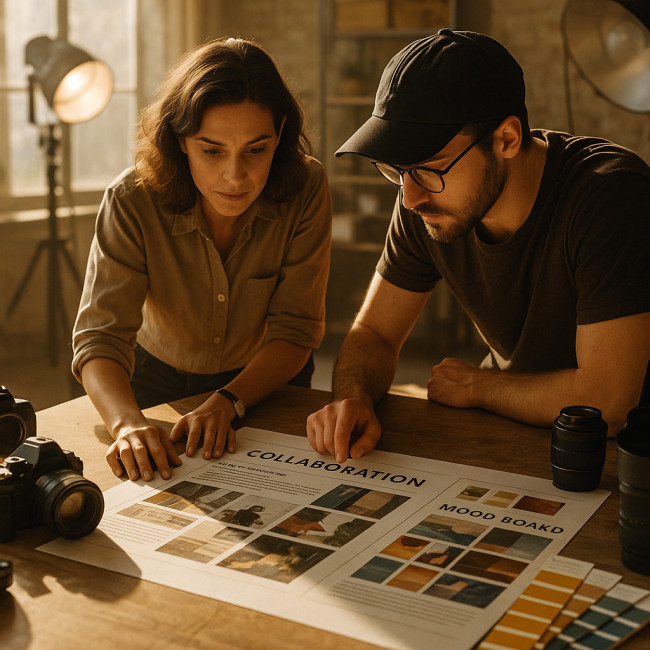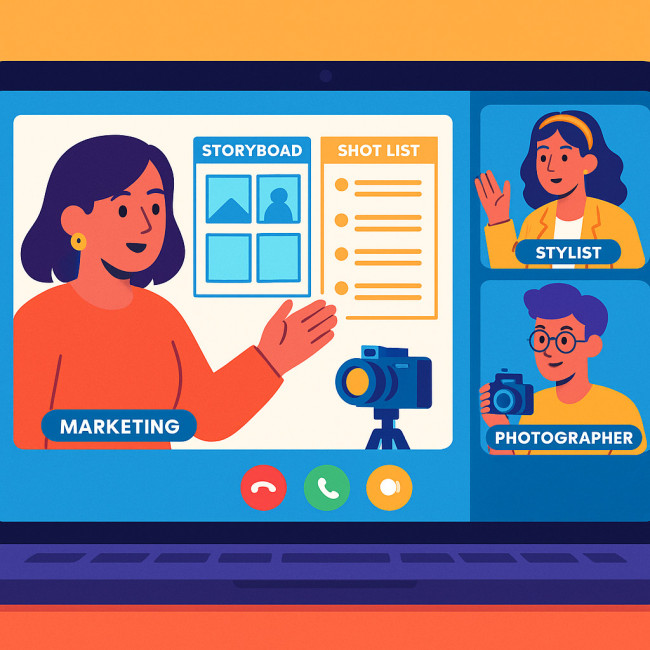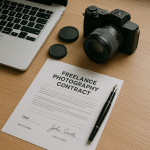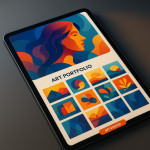Writing collaboration briefs that attract the right photographer partners
Want photographers to say “yes” to your project—and nail the visuals on the first take? Craft a collaboration brief that speaks their language, clarifies scope, and showcases your professionalism. In this guide, you'll learn the exact sections to include, wording tips that cut revisions, and smart extras (like mood boards and usage clauses) that elevate your brief above the inbox noise.
Why a crystal-clear brief wins you better photos

Look at the scene above and imagine the efficiency ripple effect. The producer highlights deliverables while the photographer notes lighting angles, the stylist lays out wardrobe swatches next to the call sheet, and everyone signs off before a single shutter clicks. That kind of tangible alignment is exactly what you buy when you invest an extra hour in writing a granular brief. Instead of troubleshooting props on set, you're free to chase fleeting golden-hour light or coach talent into authentic expressions. Clarity breeds creative courage—and that always translates into stronger images and lower costs.
Photographers juggle creative vision with tight production logistics. When your brief removes ambiguity, they can focus on delivering standout imagery instead of second-guessing expectations. The result: fewer back-and-forth emails, smoother shoot days, and visuals that slot straight into your campaign.
- Saves money: well-scoped briefs reduce hidden costs like extra retouching hours.
- Speeds timelines: clear deliverables allow photographers to build accurate shot lists and schedules upfront.
- Boosts interest: pros choose projects that respect their workflow; a polished brief signals you value their time.
The six must-have sections of a magnetic collaboration brief
1. Project overview
Open with a 100-word elevator pitch. Name the brand, campaign goal, target audience, and the core story you want the visuals to tell. This context helps the photographer shape style choices—from lens selection to colour grading.
2. Visual references
Include a curated mood board or URL gallery. Platforms like collaborative mood-board tools let both sides comment in real time, ensuring everyone interprets “moody natural light” the same way.
3. Shot list & deliverables
Break down each required image set:
- Scene description
- Orientation (portrait/landscape/square)
- Usage (social, OOH, print)
- Deadline for selects and final files
Specify file formats (e.g., 16-bit TIFF + sRGB JPG) and resolution. You'll avoid last-minute reshoots when print buyers request 300 DPI assets.
4. Logistics & production details
Outline shoot dates, locations, access permits, and available crew. If you plan to source talent via an online directory, mention it up front so the photographer can prep lighting gear for each setting.
5. Budget & payment terms
Photographers appreciate transparency. Reference market benchmarks—such as transparent pricing tiers—then list line items: creative fee, usage fee, post-production, travel, and contingency.
6. Licensing & legal clauses
State the usage period, territories, and exclusivity level. Link to your preferred template or review standard photo-contract clauses so the photographer can flag concerns before the shoot, not after delivery.
Advanced add-ons that make photographers hit “accept”

In many modern collaborations the first “set” is a laptop screen. The frame capture above illustrates how a simple thirty-minute call can surface hidden assumptions before they snowball into budget busters. A motion designer may flag the need for extra negative space; a social media manager might remind everyone that vertical reels outperform square posts; the photographer, meanwhile, can preview lighting diagrams saved from previous jobs. When each stakeholder sees the storyboard in real time, they leave the meeting with concrete action items and a shared mental picture. That mutual understanding is the secret lubricant of fast, friction-free productions.
- Creative freedom slider: allocate a percentage of shots for the photographer's personal vision. You'll gain unexpected hero images.
- Pre-production call: 30 minutes on video to walk through the storyboard saves hours on set.
- Directory link: Share your shortlist via the directory sourcing workflow so team members can review reels in one place.
- Reference URL: Encourage photographers to explore matching projects on the Artfolio collaboration job board for style alignment.
Common brief mistakes—and how to fix them fast
| Weak brief cue | Problem it causes | Fix |
|---|---|---|
| “Deliver lifestyle shots.” | Too vague—endless style options. | Specify emotion, framing, colour palette, and usage. |
| No budget range | Photographer may over- or under-quote. | Add minimum-maximum range with negotiable notes. |
| Missing timeline | Rush fees, delayed campaigns. | Set milestones: pre-prod, shoot, selects, finals. |
| Loose usage rights | Legal disputes, higher licensing bills. | Define term, territory, media, and exclusivity. |
Workflow timeline: from brief to final files
- Day 0: Send brief + mood board.
- Day 1-2: Photographer submits questions and rough quote.
- Day 3: Alignment call; adjust scope if needed.
- Day 4: Final quote, contract, and deposit.
- Day 7-10: Shoot window.
- Day 11: Low-res previews for selection.
- Day 14: Final retouched files delivered.
Mini-quiz: Are you brief-ready?
FAQ
- How long should my collaboration brief be?
- A concise two-page PDF or shared cloud doc usually covers all essentials without overwhelming the photographer.
- Is a mood board mandatory?
- While not strictly required, a mood board accelerates alignment and reduces revision rounds.
- When do I send the brief?
- Ideally 10–14 days before the desired shoot window to allow for quoting, talent booking, and location scouting.
- Can I reuse the same brief for multiple photographers?
- Yes, but personalise the intro paragraph to highlight why you're approaching that specific photographer's style.
- What if my budget is flexible?
- Provide a range and note negotiable items. Photographers can propose packages that match their workflow.
Ready to brief your next shoot?
Apply the tips above, then shortlist photographers whose style aligns with your vision. A targeted, value-packed brief will earn enthusiastic replies—and picture-perfect results.
Need a template? Download our free brief checklist and start booking top shooters today.











